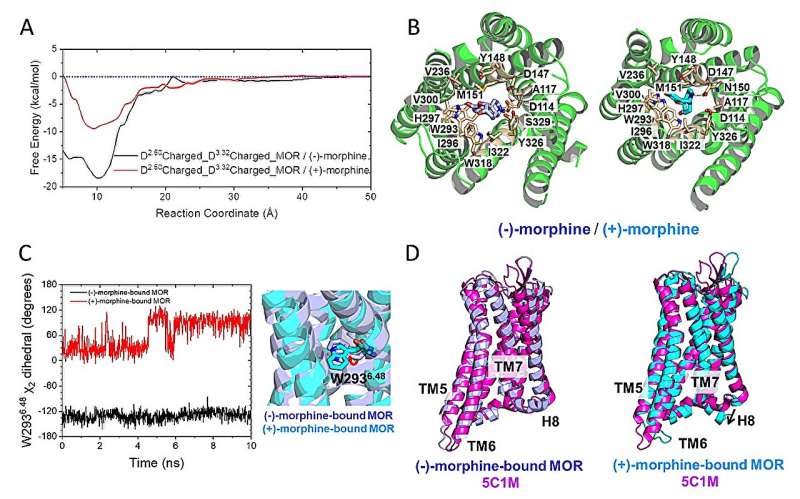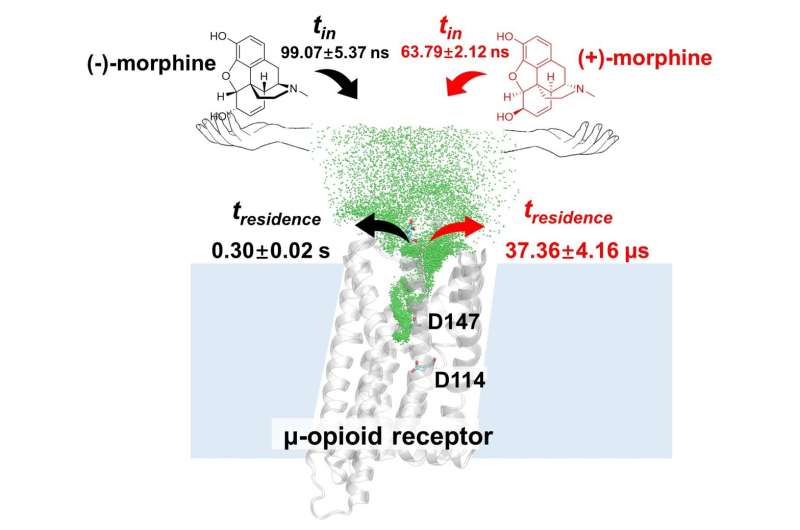This article has been reviewed according to Science X's editorial process and policies. Editors have highlighted the following attributes while ensuring the content's credibility:
fact-checked
trusted source
proofread
Deciphering how the body picks the right opioid enantiomers

A new study aimed to understand how our bodies recognize and respond to different enantiomer forms of opioid. Led by Dr. Xiaohui Wang from the Changchun Institute of Applied Chemistry, Chinese Academy of Sciences, the research has been published in the journal National Science Review.
Back in the 1950s, it was noticed that the effectiveness of opiate narcotics strongly depends on their stereochemistry. The active forms are the (-)-isomers, while the (+)-isomers have no analgesic effect. Morphine, a potent painkiller derived from the opium poppy, naturally occurs in the (-)-isomer form. However, the synthetic (+)-morphine has minimal activity and does not provide pain relief. This shows that the μ-opioid receptor (MOR) selectively responds to morphine enantiomers.
Dr. Wang states, "This has been a puzzling question in neuroscience and pharmacology for the past half century: Why does natural (-)-morphine relieve pain while (+)-morphine does not?"
Recent advancements in structural biology have allowed scientists to examine high-resolution structures of MOR, enabling the study of its stereoselectivity at the atomic level. Furthermore, molecular dynamics simulations have significantly improved our ability to dissect the thermodynamics and kinetics of the receptor-ligand interactions.
Dr. Wang adds, "The development of new technologies has given us an extra boost in understanding how MOR recognizes and responds to different enantiomer forms of morphine."
In this study, the researchers employed computer simulations to explore the thermodynamical and kinetical mechanisms of stereoselective recognition of morphine by MOR by all-atom MD simulations. They discovered that (-)-morphine binding stabilizes MOR in its activated state, exhibiting a deep energy well, therefore resulting in pain relief.
Conversely, (+)-morphine fails to sustain MOR's activation. The study also identified specific regions of MOR that undergo changes when binding to (-)-morphine.
"The selectivity in molecular recognition goes beyond binding affinities, extending into the realm of residence time," Dr. Wang says. In this study, the analysis of kinetics sheds light on the chiral recognition capability of MOR, as reflected by the residence time.
Notably, (-)-morphine demonstrated longer residence time than (+)-morphine in MOR, by a remarkable factor of 8,000. These kinetic results are in line with experimental evidence demonstrating that (-)-morphine functions as a MOR agonist while (+)-morphine exhibits minimal affinity for MOR.

By elucidating the thermodynamics and kinetics behind MOR's stereoselective recognition of morphine enantiomers, this study offers valuable insights into the fundamental workings of the opioid system. The knowledge gained from this research can potentially contribute to the development of more effective and targeted pain medications with reduced side effects.
Dr. Wang and his team are of the opinion that their discoveries lay the groundwork for more in-depth studies into the MOR and its interactions with various chiral molecules. This research has the potential to open up new paths in the fields of neuroscience and pharmacology.
By delving deeper into how MOR engages with these molecules, the team anticipates uncovering novel insights into receptor behavior, which could lead to advancements in drug development, particularly in pain management and addiction treatment. Such explorations are crucial for understanding the nuances of receptor-ligand interactions and could ultimately contribute to more effective and targeted therapeutic strategies.
More information: Yibo Wang et al, Stereoselective recognition of morphine enantiomers by μ-opioid receptor, National Science Review (2024). DOI: 10.1093/nsr/nwae029
Provided by Science China Press




















